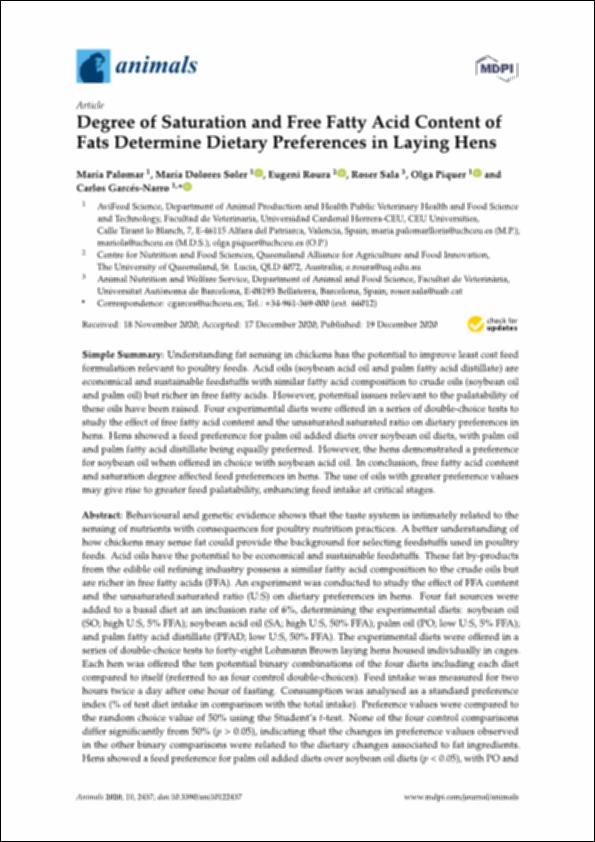Por favor, use este identificador para citar o enlazar este ítem:
http://hdl.handle.net/10637/12484Degree of saturation and free fatty acid content of fats determine dietary preferences in laying hens
| Título : | Degree of saturation and free fatty acid content of fats determine dietary preferences in laying hens |
| Autor : | Palomar Lloris, María Soler Sanchis, María Dolores Roura Escapa, Eugeni Sala Pallarés, Roser Piquer Querol, Olga Garcés Narro, Carlos |
| Materias: | Palma oil.; Hens - Feeding and feeds.; Gallinas ponedoras - Alimentación.; Alimentos para animales.; Soybean oil.; Aceite de palma.; Piensos compuestos.; Feeds - Composition.; Aceite de soja.; Animal feeds. |
| Editorial : | MDPI |
| Citación : | Palomar, M., Soler, M.D., Roura, E., Sala, R., Piquer, O. & Garcés-Narro, C. (2020). Degree of saturation and free fatty acid content of fats determine dietary preferences in laying hens. Animals, vol. 10, i. 12 (19 dec.), art. 2437. DOI: https://doi.org/10.3390/ani10122437 |
| Resumen : | Behavioural and genetic evidence shows that the taste system is intimately related to the sensing of nutrients with consequences for poultry nutrition practices. A better understanding of how chickens may sense fat could provide the background for selecting feedstu s used in poultry feeds. Acid oils have the potential to be economical and sustainable feedstu s. These fat by-products from the edible oil refining industry possess a similar fatty acid composition to the crude oils but are richer in free fatty acids (FFA). An experiment was conducted to study the e ect of FFA content and the unsaturated:saturated ratio (U:S) on dietary preferences in hens. Four fat sources were added to a basal diet at an inclusion rate of 6%, determining the experimental diets: soybean oil (SO; high U:S, 5% FFA); soybean acid oil (SA; high U:S, 50% FFA); palm oil (PO; low U:S, 5% FFA); and palm fatty acid distillate (PFAD; low U:S, 50% FFA). The experimental diets were o ered in a series of double-choice tests to forty-eight Lohmann Brown laying hens housed individually in cages. Each hen was o ered the ten potential binary combinations of the four diets including each diet compared to itself (referred to as four control double-choices). Feed intake was measured for two hours twice a day after one hour of fasting. Consumption was analysed as a standard preference index (% of test diet intake in comparison with the total intake). Preference values were compared to the random choice value of 50% using the Student’s t-test. None of the four control comparisons di er significantly from 50% (p > 0.05), indicating that the changes in preference values observed in the other binary comparisons were related to the dietary changes associated to fat ingredients. Hens showed a feed preference for palm oil added diets over soybean oil diets (p < 0.05), with PO and PFAD being equally preferred (p < 0.05). However, in this trial the hens demonstrated a preference for SO (low %FFA) when o ered in choice with SA (high %FFA) (p < 0.05). These results suggest that the degree of saturation plays an important role in dietary fat preferences: hens prefer predominantly saturated oils even when these are rich in FFA. Furthermore, when presented with a choice between predominantly unsaturated oils, hens prefer feed with a low %FFA. In conclusion, %FFA and the U:S ratio a ected feed preferences in hens. The use of oils with greater preference values may give rise to greater feed palatability, enhancing feed intake at critical stages. |
| Descripción : | Este artículo se encuentra disponible en la siguiente URL: https://www.mdpi.com/2076-2615/10/12/2437 Este artículo pertenece a la sección "Poultry". |
| URI : | http://hdl.handle.net/10637/12484 |
| Derechos: | http://creativecommons.org/licenses/by/4.0/deed.es |
| Fecha de publicación : | 19-dic-2020 |
| Centro : | Universidad Cardenal Herrera-CEU |
| Aparece en las colecciones: | Dpto. Producción y Sanidad Animal, Salud Pública Veterinaria y Ciencia y Tecnología de los Alimentos |
Los ítems de DSpace están protegidos por copyright, con todos los derechos reservados, a menos que se indique lo contrario.


